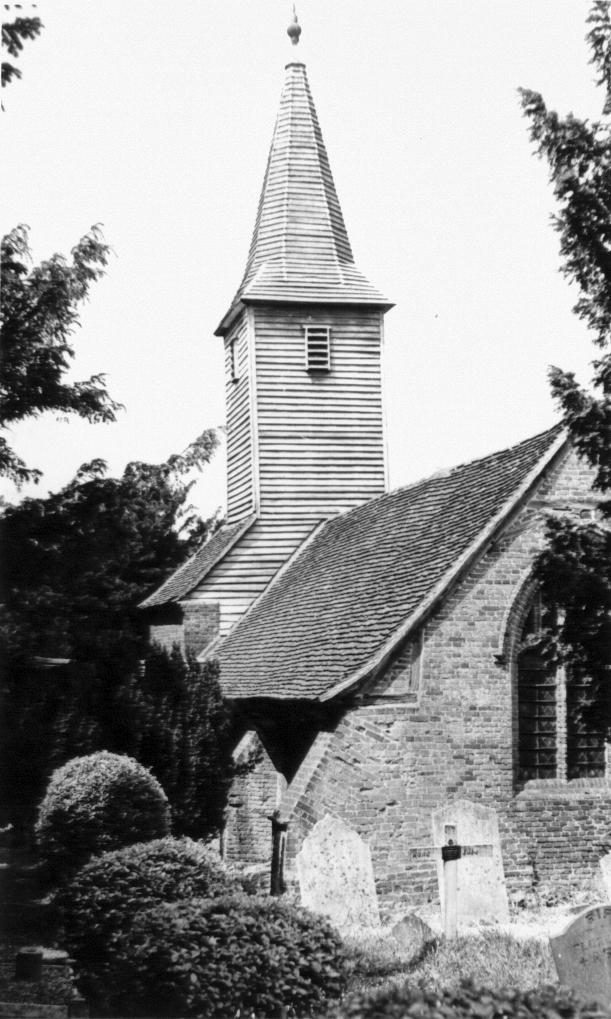The church of St. Mary and All Saints stands in Old Church
Hill, Langdon Hills. Although located in Langdon Hills the church falls within the boundary of
the Borough of Thurrock (formerly Thurrock Urban District 1936-1974; Orsett Rural District
1894-1936).
 St. Mary and All Saints, c.1930.
St. Mary and All Saints, c.1930.
Photo appears courtesy of the Essex Churches Website. |
A church is believed to have occupied this site from at least the 14th century though the present building probably dates from
sometime in the 19th century. It is documented that a restoration or substantial rebuild was carried out on the church in 1841 and
from this it could be taken as a general indicator to the age of the present structure.Despite the restoration, its location part
way down one of the steepest hills in the local area put it at a disadvantage to best serve the growing local community and in 1877
a new St. Mary's and All Saints church was built at the summit of Crown Hill. This effectively rendered the church semi redundant
to all but burial services. The new church was the work of the then Rector Easby Digby Cleaver who is said to have financed its
construction from his own funds. With infrequent use by the turn of the 1930s the condition of St. Mary had become the
cause of great concern which prompted the then rector Cecil Edleston Livesey to launch an appeal for funds. A substantial donation
from local benefactor Miss Wheaton, whose family lived and worked the land closeby at Hall Farm, enabled another restoration,
costing around £550, to be carried out but unfortunately by the 1960s the church had once again fallen into a ruinous condition and was declared
redundant; effective from Tuesday 19th October, 1971. It is not known exactly when the last service, for whatever reason that may
have been, took place. Now reduntant the condition of the church continued to deteriorate as a result of general neglect and a growing vandalism problem
prompting the Church Commissioners to submit a 'Scheme by Order in Council' whereby the church could be converted to a private residence*. This was
confirmed on 19th January 1973 and the church was soon sold and duly converted by 1975 to a private residence, which it remains today. In August 1981 the building was designated a
Grade II listed building. The change of use to residential does not affect the churchyard which has unrestricted access to
the general public.
The Churchyard A new portion of churchyard was consecrated on Sunday 10th June, 1928 by the Bishop of Barking, James Theodore
Inskip. In 1964 a short article on St. Mary and All Saints by renowned local historian Jessie K. Payne appeared in a local newspaper*. In the
piece, entitled "Many Victorian relics in this church", she wrote:
At the bottom of a steep hill stands the tiny church of St. Mary and All Saints'. Outside the east window, sunk deep in the timber, is a crossbow
bolt, a reminder that it was not always peaceful here, and on the left of the path to the porch is Robert Benton's gravestone; he died in 1712.
Inside the church that has not been used for 87 years the past leaps to life. Facing the door is a row of iron hat pegs where men in Victorian days
hung their hats before going to sit in the box pews which still stand in the north transept. One pew is said to have been for the landlord of the Crown
Inn. Here also is the parish bier in which the coffins of poor people in the village were wheeled to the churchyard for burial.
The three-deckers pulpit is an unusual survival, the preacher occupied the top, the reader of the scripture the middle and the clerk the bottom.
At the west end of the church is a musicians' gallery where the villagers made their own music with flutes, oboes and other instruments.
There are two bells; one was brought here in 1458 from the old church of West Lee 26 years after the parishes were united. West Lee church stood
near Westley Hall Farm. Over the rood beam where the figures of Our Lord, St. Mary and St. John stood before the Reformation is a framing
filled with plaster on which is painted the Royal Arms of Charles II put up at the Restoration. There are only two other "Restoration" Arms in existence. On
the underside of the beam is a groove where the rood screen was fixed which originally divided the chancel from the nave.
The first recorded rector was Gregory in 1200. The church belonged to Beeleigh Abbey near Maldon and in 1212 Henry Abbot of Beeleigh, was
rector. After the new church on the hilltop was built in 1876 the old church was used for burial services only and, subsequently, became in such
bad repair that it was closed as being unsafe. In 1931 it was restored, but once more funds are needed for its repair.
The following is taken from the 1894 edition of Kelly's Directory of Essex. The old church of St. Mary the Virgin
and All Saints, situated on the west side of the hill, consists of chancel, nave and north chapel, but is now used only as a mortuary
chapel. The directory of 1914 is identical to that of 1894 with one addition: The old church of St. Mary the Virgin and
All Saints, situated on the west side of the hill, consists of chancel, nave and north chapel, but is now used for service occasionally
and as a mortuary chapel.
| 
